Found this great article on stack ventilation and bernoulli’s principle
Stack ventilation and Bernoulli’s principle are two kinds of passive ventilation that use air pressure differences due to height to pull air through the building. Lower pressures higher in the building help pull air upward. The difference between stack ventilation and Bernoulli’s principle is where the pressure difference comes from.

Stack ventilation uses temperature differences to move air. Hot air rises because it is lower pressure. For this reason, it is sometimes called buoyancy ventilation.
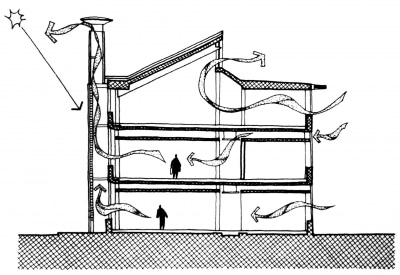
Bernoulli’s principle uses wind speed differences to move air. It is a general principle of fluid dynamics, saying that the faster air moves, the lower its pressure. Architecturally speaking, outdoor air farther from the ground is less obstructed, so it moves faster than lower air, and thus has lower pressure. This lower pressure can help suck fresh air through the building. A building’s surroundings can greatly affect this strategy, by causing more or less obstruction.
The advantage of Bernoulli’s principle over the stack effect is that it multiplies the effectiveness of wind ventilation. The advantage of stack ventilation over Bernoulli’s principle is that it does not need wind: it works just as well on still, breezeless days when it may be most needed. In many cases, designing for one effectively designs for both, but some strategies can be employed to emphasize one or the other. For instance, a simple chimney optimizes for the stack effect, while wind scoops optimize for Bernoulli’s principle.
For example, the specially-designed wind cowls in the BedZED development use the faster winds above rooftops for passive ventilation. They have both intake and outlet, so that fast rooftop winds get scooped into the buildings, and the larger outlets create lower pressures to naturally suck air out. The stack effect also helps pull air out through the same exhaust vent.
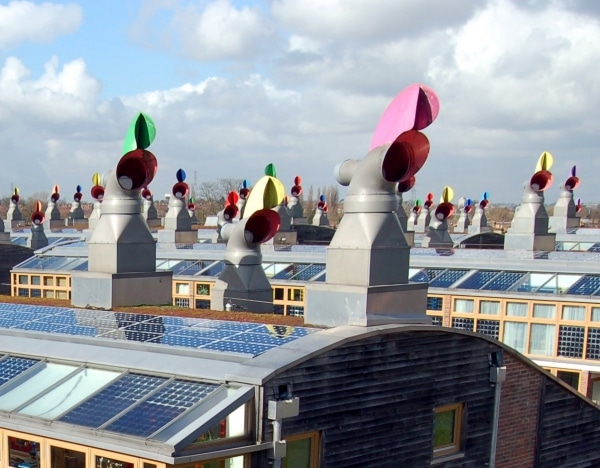
After wind ventilation, stack ventilation is the most commonly used form of passive ventilation. It and Bernoulli’s principle can be extremely effective and inexpensive to implement. Typically, at night, wind speeds are slower, so ventilation strategies driven by wind is less effective. Therefore, stack ventilation is an important strategy.
Successful passive ventilation using these strategies is measured by having high thermal comfort and adequate fresh air for the ventilated spaces, while having little or no energy use for active HVAC cooling and ventilation.
Strategies for Stack Ventilation and Bernoulli’s Principle
Designing for stack ventilation and Bernoulli’s principle are similar, and a structure built for one will generally have both phenomena at work. In both strategies, cool air is sucked in through low inlet openings and hotter exhaust air escapes through high outlet openings. The ventilation rate is proportional to the area of the openings. Placing openings at the bottom and top of an open space will encourage natural ventilation through stack effect. The warm air will exhaust through the top openings, resulting in cooler air being pulled into the building from the outside through the openings at the bottom. Openings at the top and bottom should be roughly the same size to encourage even air flow through the vertical space.
To design for these effects, the most important consideration is to have a large difference in height between air inlets and outlets. The bigger the difference, the better.
Towers and chimneys can be useful to carry air up and out, or skylights or clerestories in more modest buildings. For these strategies to work, air must be able to flow between levels. Multi-story buildings should have vertical atria or shafts connecting the airflows of different floors.
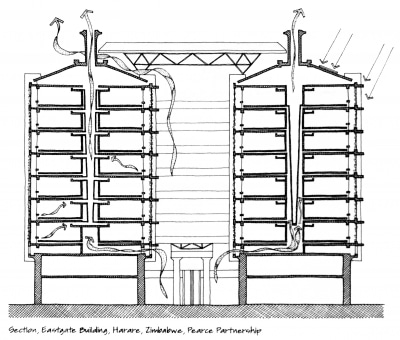
Solar radiation can be used to enhance stack ventilation in tall open spaces. By allowing solar radiation into the space (by using equator facing glazing for example), you can heat up the interior surfaces and increase the temperature that will accelerate stack ventilation between the top and bottom openings.
Installing weatherproof vents to passively ventilate attic spaces in hot climates is an important design strategy that is often overlooked. In addition to simply preventing overheating1, ventilated attics can use these principles to actually help cool a building. There are several styles of passive roof vents: Open stack, turbine, gable, and ridge vents, to name a few.

To allow adjustability in the amount of cooling and fresh air provided by stack ventilation and Bernoulli systems, the inlet openings should be adjustable with operable windows or ventilation louvers. Such systems can be mechanized and controlled by thermostats to optimize performance.
Stack ventilation and the Bernoulli effect can be combined with cross-ventilation as well. This matrix shows how multiple different horizontal and vertical air pathways can be combined.
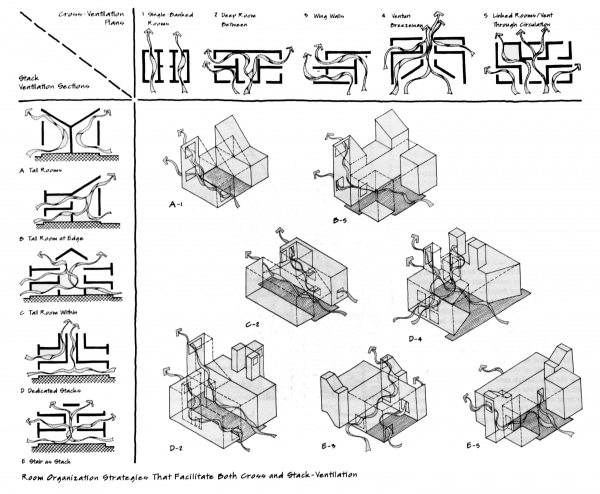
Solar Chimneys
A solar chimney uses the sun’s heat to provide cooling, using the stack effect. Solar heat gain warms a column of air, which then rises, pulling new outside air through the building. They are also called thermal chimneys, thermosiphons, or thermosyphons.
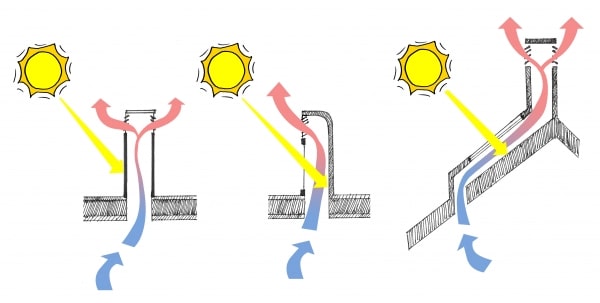
The simplest solar chimney is merely a chimney painted black. Many outhouses in parks use such chimneys to provide passive ventilation. Solar chimneys need their exhaust higher than roof level, and need generous sun exposure. They are generally most effective for climates with a lot of sun and little wind; climates with more wind on hot days can usually get more ventilation using the wind itself.
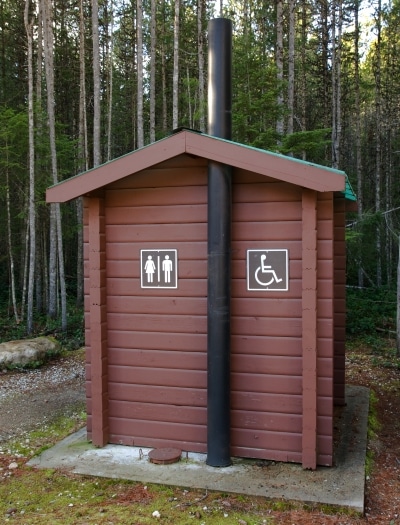
Advanced solar chimneys can involve Trombe walls or other means of absorbing and storing heat in the chimney to maximize the sun’s effect, and keep it working after sunset. Unlike a Trombe wall, solar chimneys are generally best when insulated from occupied spaces, so they do not transfer the sun’s heat to those spaces but only provide cooling.
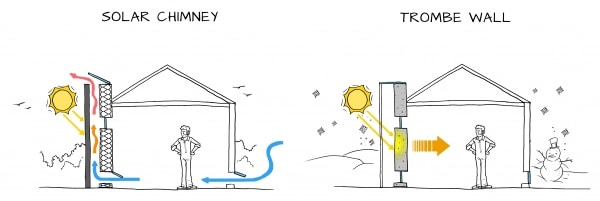
Thermal chimneys can also be combined with means of cooling the incoming air, such as evaporative cooling or geothermal cooling.
Solar chimneys can also be used for heating, much like a Trombe wall is. If the top exterior vents are closed, the heated air is not exhausted out the top; at the same time, if high interior vents are opened to let the heated air into occupied spaces, it will provide convective air heating.
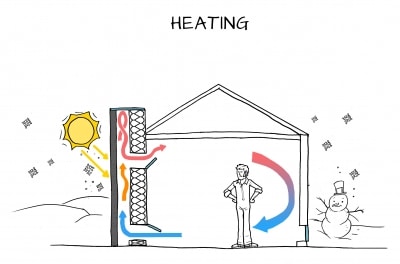
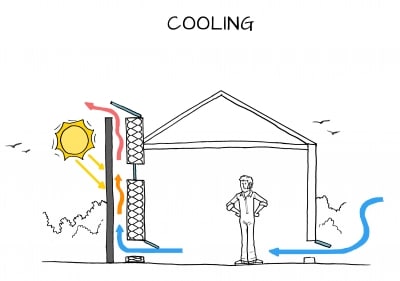
1 According to the National Renewable Energy Laboratory, ventilated attics can be 16°C (30°F) cooler than unventilated ones.


